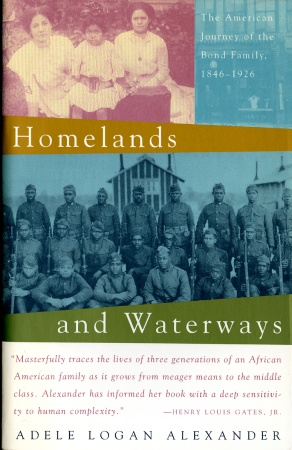Homelands and Waterways: The American Journey of the Bond Family, 1846-1926Posted in Biography, Books, History, Media Archive, Monographs, Slavery, Social Science, United States on 2010-02-22 04:41Z by Steven |
Homelands and Waterways: The American Journey of the Bond Family, 1846-1926
Vintage Press an imprint of Random House
1999
720 pages
Paperback ISBN: 978-0-679-75871-6 (0-679-75871-2)
Adele Logan Alexander, Professor of History
George Washington University
Winner for the top non-fiction prize of the Black Caucus of the American Library Association
This monumental history traces the rise of a resolute African American family (the author’s own) from privation to the middle class. In doing so, it explodes the stereotypes that have shaped and distorted our thinking about African Americans–both in slavery and in freedom.
Beginning with John Robert Bond, who emigrated from England to fight in the Union Army during the Civil War and married a recently freed slave, Alexander shows three generations of Bonds as they take chances and break new ground.
From Victorian England to antebellum Virginia, from Herman Melville‘s New England to the Jim Crow South, from urban race riots to the battlefields of World War I, this fascinating chronicle sheds new light on eighty crucial years in our nation’s troubled history. The Bond family’s rise from slavery, their interaction with prominent figures such as W. E. B. DuBois and Booker T. Washington, and their eventual, uneasy realization of the American dream shed a great deal of light on our nation’s troubled heritage.
See Adele Logan Alexander of speak about tracing her racial identity through her family roots in her book “Homelands and Waterways” in an interview on the Charlie Rose Show from 1999-10-26 here.





